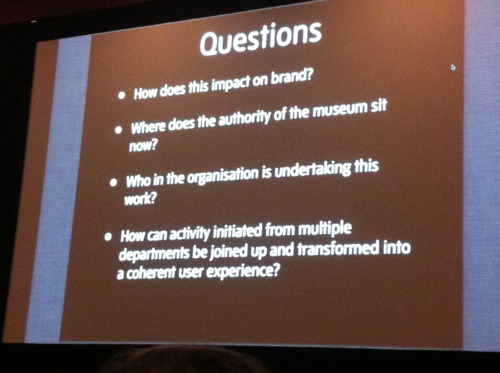On Tuesday last, I attended an event at Tate Britain about ‘designing for community-powered digital transformations’ (#DigitalTrans). I decided that I would blog about it, but then thought that it might be an interesting idea to wait and compare it with the Creative Exchange launchpad event (#CXHub) that I was attending the next day. I thought similar ideas might come out of both events, that it’d be a good comparison.
Well, I was right, but it didn’t pan out quite the way I expected. It’s probably very telling that I wrote about the CXHub event the very next day in superlative terms, and have left this until a full week later.
The DigitalTrans event kicked off with a talk by John Stack (Head of Tate Online), followed by one from Jake Berger (Programme Manager for the BBC’s Digital Public Space). Mr Stack’s presentation was essentially an overview of the Tate’s online endeavours. I thought it might go on to something else but it didn’t, which was disappointing. Going over the notes I made during his talk, I see mainly questions – and not inspiring ones. At one point he referred to an unnamed website as a “young persons’ website”, and I was baffled as to what he meant. Tumblr? Twitter? CBeebies? I think it was something like the former, judging from the context, but the notion that such sites are considered solely the domain of ‘young people’ chafed. It seems dismissive, and suggests to me that they do not take such communities as seriously as they should.
This seemed to be further suggested by the Tate’s haphazard use of different social media platforms away from Facebook and Twitter, as demonstrated in the presentation. It seems that they have a tendency to run one competition or project on a platform (such as Tumblr or Threadless) and then abandon it once it’s finished. I appear to have written down the phrase “social media roulette” in my notes. Perhaps I’ve misunderstood their methods somehow, but if this is the case, then that is really not the way to engage with audiences online, and suggests a real misunderstanding of online communities.

Moving on, Jake Berger talked about The Space. I admit that I was also confused by his presentation, and do not think he represented The Space very well; I went in understanding The Space, and came out not understanding it at all! He claimed that the site’s content was “lightly curated”, much to my bewilderment. All of the projects on The Space were specifically chosen from hundreds of applications, those that were rejected likely died in the water – how does this constitute ‘light curation’?* Still, I learned that The Space is built on a hacked version of WordPress (which is pretty interesting), and that they will be open-sourcing the code at the end of the year, which is great.
The presentations by Martin Rieser (De Monfort University), Claire Ross (UCL), and Sunil Manghani (York St John University) were substantially more interesting, but I’m afraid the darkened room had left me feeling rather zoned out and my attention was starting to wander. Nonetheless, I noted a few key points. Mr Rieser (who largely talked about mapping) mentioned the potential impact of digital content on ‘offline life’. Mr Manghani asked if the internet was getting to a stage where we either ‘like’ things or ignore them entirely, and observed that individual interpretation is spawned by our own experiences, which is certainly worth considering when thinking about engagement methods.
Ms Ross’s talk was the most interesting, in my opinion (and would turn out to be most like the talks at CXHub). She spoke specifically about user-centric design and I was sorry that her comments didn’t get more discussion. She said that online organisations need to “welcome change [and] deliver frequently” whilst also “failing faster” to encourage constant re-evaluation and thus improvements. She also promoted the notion of radical trust, which made for an interesting contrast with earlier discussion where attendees had expressed a mistrust of online commenters (and fear of trolls), and debated how best to ‘curate feedback’. I also thought the concept of feedback being stored with the original object’s data in its content management system (in the case of physical collections) was a progressive one.
I had expected this event to be about how communities, both online and offline, are changing the shape of the internet. I wanted to hear about where all this was leading, how organisations are preparing for the changes yet to come. I expected lots of fascinating new concepts. Instead, I often felt like I was an interloper in a kind of corporate ‘ideas workshop’. There were repeated questions about the evaluation of data and the value of engagement. I felt like many of the people there were only working on audience engagement as an ends to acquiring data or because they felt they should be, not because they felt it could enrich their collections or improve the experiences of their audiences.
I feel quite bad about criticising this event – the organisers and participators were clearly trying their best to present an up-to-date discussion of digital trends. But Ms Ross’s talk aside, it simply it wasn’t forward-thinking, and in comparison to the ideas floating round at CXHub the next day, it was desperately outmoded. It just didn’t seem to really talk about what it was supposed to, instead turning into a kind of show-and-tell.
All in all, I came away feeling very tired from sitting in a darkened room all day, and wholly uninspired, which is a real shame.
—
* Bill Thompson cleared up my confusion regarding The Space at the CXHub when he said that The Space is essentially a means for the Art Council to commission digital art, and the BBC to experiment with delivery platforms.